Genome-Wide Identification, Molecular Characterization, and Involvement in Response to Abiotic and Biotic Stresses of the HSP70 Gene Family in Turbot (Scophthalmus maximus)
Abstract
1. Introduction
2. Results
2.1. Identification and Characteristics of HSP70 Genes in Turbot
2.2. Phylogenetic Analysis of HSP70 Genes among Teleost Species
2.3. Chromosomal Distribution and Selection Test of Duplicated HSP70 Genes
2.4. Exon–Intron Structure and Motif Analysis of HSP70 Genes
2.5. Subcellular Localization and Protein Structure Analysis
2.6. Expression Patterns of HSP70 Genes under Abiotic Stresses
2.7. Expression Patterns of HSP70 Genes under Biotic Stresses
2.8. qPCR Validation of HSP70 Gene Candidates Involved in Comprehensive Anti-Stress Responses
3. Discussion
4. Materials and Methods
4.1. Genome-Wide Identification and Sequence Analysis of HSP70 Genes in Turbot
4.2. Phylogenetic Analysis of the HSP70 Genes
4.3. Chromosome Distribution and Molecular Evolution Analysis
4.4. Gene Structure Analysis and Conserved Motif Identification
4.5. Subcellular Localization and Protein Structure Prediction of HSP70
4.6. RNA-seq Datasets Used for the Expression Profiles of HSP70 Genes under Abiotic Stresses
4.7. RNA-seq Datasets Used for the Expression Profiles of HSP70 Genes under Biotic Stresses
4.8. Expression Analyses of HSP70 Genes
4.9. Heat Stress and Edwardsiella Tarda Challenge Experiment
4.10. Quantitative Real-Time PCR (qPCR)
5. Conclusions
Supplementary Materials
Author Contributions
Funding
Institutional Review Board Statement
Informed Consent Statement
Data Availability Statement
Acknowledgments
Conflicts of Interest
References
- Ritossa, F.M. A new puffing pattern induced by temperature shock and DNP in drosophila. Experientia 1962, 18, 571–573. [Google Scholar] [CrossRef]
- Feder, M.E.; Hofmann, G.E. Heat-shock proteins, molecular chaperones, and the stress response: Evolutionary and ecological physiology. Annu. Rev. Physiol. 1999, 61, 243–282. [Google Scholar] [CrossRef] [PubMed]
- Kampinga, H.H.; Hageman, J.; Vos, M.J.; Kubota, H.; Tanguay, R.M.; Bruford, E.A.; Cheetham, M.E.; Chen, B.; Hightower, L.E. Guidelines for the nomenclature of the human heat shock proteins. Cell Stress Chaperones 2009, 14, 105–111. [Google Scholar] [CrossRef] [PubMed]
- Hartl, F.U.; Bracher, A.; Hayer-Hartl, M. Molecular chaperones in protein folding and proteostasis. Nature 2011, 475, 324–332. [Google Scholar] [CrossRef]
- Kiang, J.G.; Tsokos, G.C. Heat shock rotein 70 kDa molecular biology, biochemistry, and physiology. Pharmacol. Ther. 1998, 80, 183–201. [Google Scholar] [CrossRef]
- Gupta, A.; Bansal, A.; Hashimoto-Torii, K. HSP70 and HSP90 in neurodegenerative diseases. Neurosci. Lett. 2020, 716, 134678. [Google Scholar] [CrossRef]
- Daugaard, M.; Rohde, M.; Jaattela, M. The heat shock protein 70 family: Highly homologous proteins with overlapping and distinct functions. FEBS Lett. 2007, 581, 3702–3710. [Google Scholar] [CrossRef]
- Boone, A.N.; Vijayan, M.M. Constitutive heat shock protein 70 (HSC70) expression in rainbow trout hepatocytes: Effect of heat shock and heavy metal exposure. Comp. Biochem. Phys. C 2002, 132, 223–233. [Google Scholar] [CrossRef]
- Frydman, J. Folding of newly translated proteins in vivo: The role of molecular chaperones. Annu. Rev. Biochem. 2001, 70, 603–647. [Google Scholar] [CrossRef]
- Ellis, J. Proteins as molecular chaperones. Nature 1987, 328, 378–379. [Google Scholar] [CrossRef]
- Auluck, P.K.; Chan, H.Y.E.; Trojanowski, J.Q. Chaperone suppression of α-synuclein toxicity in a Drosophila model for Parkinson's disease. Science 2002, 295, 865–868. [Google Scholar] [CrossRef] [PubMed]
- Moseley, P.L. Heat shock proteins and heat adaptation of the whole organism. J. Appl. Physiol. 1997, 83, 1413–1417. [Google Scholar] [CrossRef] [PubMed]
- Shi, Q.; Yu, C.; Zhu, D.; Li, S.; Wen, X. Effects of dietary Sargassum horneri on resisting hypoxia stress, which changes blood biochemistry, antioxidant status, and hepatic HSP mRNA expressions of juvenile black sea bream Acanthopagrus schlegelii. J. Appl. Phycol. 2020, 32, 3457–3466. [Google Scholar] [CrossRef]
- Song, L.; Li, C.; Xie, Y.; Liu, S.; Zhang, J.; Yao, J.; Jiang, C.; Li, Y.; Liu, Z. Genome-wide identification of Hsp70 genes in channel catfish and their regulated expression after bacterial infection. Fish Shellfish. Immunol. 2016, 49, 154–162. [Google Scholar] [CrossRef]
- Deane, E.E.; Woo, N.Y.S. Impact of heavy metals and organochlorines on hsp70 and hsc70 gene expression in black sea bream fibroblasts. Aquat. Toxicol. 2006, 79, 9–15. [Google Scholar] [CrossRef]
- Mosser, D.D.; Theodorakis, N.G.; Morimoto, R.I. Coordinate changes in heat shock element-binding activity and HSP70 gene transcription rates in human cells. Mol. Cell. Biol. 1988, 8, 4736–4744. [Google Scholar] [CrossRef]
- Tsan, M.F.; Gao, B. Heat shock proteins and immune system. J. Leukoc. Biol. 2009, 85, 905–910. [Google Scholar] [CrossRef]
- Sun, Y.; Wen, H.; Tian, Y.; Mao, X.; Li, X.; Li, J.; Hu, Y.; Liu, Y.; Li, J.; Li, Y. HSP90 and HSP70 families in Lateolabrax maculatus: Genome-wide identification, molecular characterization, and expression profiles in response to various environmental stressors. Front. Physiol. 2021, 12, 784803. [Google Scholar] [CrossRef]
- Xu, K.; Xu, H.; Han, Z. Genome-wide identification of Hsp70 genes in the large yellow croaker (Larimichthys crocea) and their regulated expression under cold and heat stress. Genes 2018, 9, 590. [Google Scholar] [CrossRef]
- Deng, Z.; Sun, S.; Gao, T.; Han, Z. The Hsp70 gene family in Boleophthalmus pectinirostris: Genome-wide identification and expression analysis under high ammonia stress. Animals 2019, 9, 36. [Google Scholar] [CrossRef]
- Deng, Z.; Liu, H.; He, C.; Shou, C.; Han, Z. Heat shock protein 70 (Hsp70) and heat shock transcription factor (Hsf) gene families in Cynoglossus semilaevis: Genome-wide identification and correlation analysis in response to low salinity stress. Mar. Freshw. Res. 2021, 72, 1132–1141. [Google Scholar] [CrossRef]
- Ma, F.; Luo, L. Genome-wide identification of Hsp70/110 genes in rainbow trout and their regulated expression in response to heat stress. PeerJ 2020, 8, e10022. [Google Scholar] [CrossRef] [PubMed]
- Liu, K.; Hao, X.; Wang, Q.; Hou, J.; Lai, X.; Dong, Z.; Shao, C. Genome-wide identification and characterization of heat shock protein family 70 provides insight into its divergent functions on immune response and development of Paralichthys olivaceus. PeerJ 2019, 7, e7781. [Google Scholar] [CrossRef] [PubMed]
- Bjørndal, T.; Øiestad, V. The Development of a New Farmed Species: Production Technology and Markets for Turbot; Working Paper; Institute for Research in Economics and Business Administration: Bergen, Norway, 2010. [Google Scholar]
- Lei, J.L.; Liu, X.F.; Guan, C.T. Turbot culture in China for two decades: Achievements and prospect. Prog. Fish. Sci. 2012, 33, 123–130. [Google Scholar] [CrossRef]
- Huang, Z.; Ma, A.; Yang, S.; Liu, X.; Zhao, T.; Zhang, J.; Wang, X.A.; Sun, Z.; Liu, Z.; Xu, R. Transcriptome analysis and weighted gene co-expression network reveals potential genes responses to heat stress in turbot Scophthalmus maximus. Comp. Biochem. Physiol. D-Genom. Proteom. 2020, 33, 100632. [Google Scholar] [CrossRef]
- Liu, Z.; Ma, A.; Yuan, C.; Zhao, T.; Chang, H.; Zhang, J. Transcriptome analysis of liver lipid metabolism disorders of the turbot Scophthalmus maximus in response to low salinity stress. Aquaculture 2021, 534, 736273. [Google Scholar] [CrossRef]
- Cui, W.; Ma, A.; Huang, Z.; Wang, X.a.; Sun, Z.; Liu, Z.; Zhang, W.; Yang, J.; Zhang, J.; Qu, J. Transcriptomic analysis reveals putative osmoregulation mechanisms in the kidney of euryhaline turbot Scophthalmus maximus responded to hypo-saline seawater. J. Oceanol. Limnol. 2019, 38, 467–479. [Google Scholar] [CrossRef]
- Ronza, P.; Alvarez-Dios, J.A.; Robledo, D.; Losada, A.P.; Romero, R.; Bermudez, R.; Pardo, B.G.; Martinez, P.; Quiroga, M.I. Blood transcriptomics of turbot Scophthalmus maximus: A tool for health monitoring and disease studies. Animals 2021, 11, 1296. [Google Scholar] [CrossRef]
- Gao, C.; Cai, X.; Cao, M.; Fu, Q.; Yang, N.; Liu, X.; Wang, B.; Li, C. Comparative analysis of the miRNA-mRNA regulation networks in turbot (Scophthalmus maximus L.) following Vibrio anguillarum infection. Dev. Comp. Immunol. 2021, 124, 104164. [Google Scholar] [CrossRef]
- Ronza, P.; Robledo, D.; Bermudez, R.; Losada, A.P.; Pardo, B.G.; Sitja-Bobadilla, A.; Quiroga, M.I.; Martinez, P. RNA-seq analysis of early enteromyxosis in turbot (Scophthalmus maximus): New insights into parasite invasion and immune evasion strategies. Int. J. Parasitol. 2016, 46, 507–517. [Google Scholar] [CrossRef]
- Song, Y.; Dong, X.; Hu, G. Transcriptome analysis of turbot (Scophthalmus maximus) head kidney and liver reveals immune mechanism in response to Vibrio anguillarum infection. J. Fish Dis. 2022, 45, 1045–1057. [Google Scholar] [CrossRef] [PubMed]
- Xu, X.-w.; Zheng, W.; Meng, Z.; Xu, W.; Liu, Y.; Chen, S. Identification of stress-related genes by co-expression network analysis based on the improved turbot genome. Sci. Data 2022, 9, 374. [Google Scholar] [CrossRef] [PubMed]
- Robledo, D.; Ronza, P.; Harrison, P.W.; Losada, A.P.; Bermudez, R.; Pardo, B.G.; Redondo, M.J.; Sitja-Bobadilla, A.; Quiroga, M.I.; Martinez, P. RNA-seq analysis reveals significant transcriptome changes in turbot (Scophthalmus maximus) suffering severe enteromyxosis. BMC Genom. 2014, 15, 1149. [Google Scholar] [CrossRef] [PubMed]
- Ronza, P.; Robledo, D.; Losada, A.P.; Bermudez, R.; Pardo, B.G.; Martinez, P.; Quiroga, M.I. The teleost thymus in health and disease: New insights from transcriptomic and histopathological analyses of turbot, Scophthalmus maximus. Biology 2020, 9, 221. [Google Scholar] [CrossRef]
- Rosenzweig, R.; Nillegoda, N.B.; Mayer, M.P.; Bukau, B. The Hsp70 chaperone network. Nat. Rev. Mol. Cell Biol. 2019, 20, 665–680. [Google Scholar] [CrossRef]
- Karlin, S.; Brocchieri, L. Heat shock protein 70 family: Multiple sequence comparisons, function, and evolution. J. Mol. Evol. 1998, 47, 565–577. [Google Scholar] [CrossRef]
- Gao, L.; Yuan, Z.; Yu, S.; Yang, Y.; Li, Y.; He, C. Genome-wide identification of HSP70/110 genes in sea cucumber Apostichopus japonicus and comparative analysis of their involvement in aestivation. Comp. Biochem. Physiol. D-Genom. Proteom. 2018, 28, 162–171. [Google Scholar] [CrossRef]
- Hu, Z.; Song, H.; Feng, J.; Zhou, C.; Yang, M.-J.; Shi, P.; Yu, Z.-L.; Li, Y.-R.; Guo, Y.-J.; Li, H.-Z.; et al. Massive heat shock protein 70 genes expansion and transcriptional signatures uncover hard clam adaptations to heat and hypoxia. Front. Mar. Sci. 2022, 9, 898669. [Google Scholar] [CrossRef]
- Jin, S.; Deng, Z.; Xu, S.; Zhang, H.; Han, Z. Genome-wide identification and low-salinity stress analysis of the Hsp70 gene family in swimming crab (Portunus trituberculatus). Int. J. Biol. Macromol. 2022, 208, 126–135. [Google Scholar] [CrossRef]
- Zhang, G.; Fang, X.; Guo, X.; Li, L.; Luo, R.; Xu, F.; Yang, P.; Zhang, L.; Wang, X.; Qi, H.; et al. The oyster genome reveals stress adaptation and complexity of shell formation. Nature 2012, 490, 49–54. [Google Scholar] [CrossRef]
- Brocchieri, L.; de Macario, E.C.; Macario, A.J.L. hsp70 genes in the human genome: Conservation and differentiation patterns predict a wide array of overlapping and specialized functions. BMC Evol. Biol. 2008, 8, 19. [Google Scholar] [CrossRef] [PubMed]
- Moore, R.C.; Purugganan, M.D. The early stages of duplicate gene evolution. Proc. Natl. Acad. Sci. U.S.A. 2003, 100, 15682–15687. [Google Scholar] [CrossRef] [PubMed]
- Kong, H.; Landherr, L.L.; Frohlich, M.W.; Leebens-Mack, J.; Ma, H.; dePamphilis, C.W. Patterns of gene duplication in the plant SKP1 gene family in angiosperms: Evidence for multiple mechanisms of rapid gene birth. Plant J. 2007, 50, 873–885. [Google Scholar] [CrossRef] [PubMed]
- Voldoire, E.; Brunet, F.; Naville, M.; Volff, J.-N.; Galiana, D. Expansion by whole genome duplication and evolution of the sox gene family in teleost fish. PLoS ONE 2017, 12, e0180936. [Google Scholar] [CrossRef] [PubMed]
- Holub, E.B. The arms race is ancient history in Arabidopsis, the wildflower. Nat. Rev. Genet. 2001, 2, 516–527. [Google Scholar] [CrossRef]
- Wang, J.; Pan, C.; Wang, Y.; Ye, L.; Wu, J.; Chen, L.; Zou, T.; Lu, G. Genome-wide identification of MAPK, MAPKK, and MAPKKK gene families and transcriptional profiling analysis during development and stress response in cucumber. BMC Genom. 2015, 16, 386. [Google Scholar] [CrossRef]
- Zhang, J.; Li, J.; Liu, B.; Zhang, L.; Chen, J.; Lu, M. Genome-wide analysis of the Populus Hsp90 gene family reveals differential expression patterns, localization, and heat stress responses. BMC Genom. 2013, 14, 532. [Google Scholar] [CrossRef]
- Huang, X.; Li, S.; Gao, Y.; Zhan, A. Genome-wide identification, characterization and expression analyses of heat shock protein-related genes in a highly invasive ascidian Ciona savignyi. Front. Physiol. 2018, 9, 1043. [Google Scholar] [CrossRef]
- Tamura, K.; Stecher, G.; Kumar, S. MEGA11: Molecular evolutionary genetics analysis version 11. Mol. Biol. Evol. 2021, 38, 3022–3027. [Google Scholar] [CrossRef]
- Chen, C.; Chen, H.; Zhang, Y.; Thomas, H.R.; Frank, M.H.; He, Y.; Xia, R. TBtools: An integrative toolkit developed for interactive analyses of big biological data. Mol. Plant 2020, 13, 1194–1202. [Google Scholar] [CrossRef]
- Bailey, T.L.; Johnson, J.; Grant, C.E.; Noble, W.S. The MEME Suite. Nucleic Acids Res. 2015, 43, W39–W49. [Google Scholar] [CrossRef] [PubMed]
- Zhao, T.; Ma, A.; Huang, Z.; Liu, Z.; Sun, Z.; Zhu, C.; Yang, J.; Li, Y.; Wang, Q.; Qiao, X.; et al. Transcriptome analysis reveals that high temperatures alter modes of lipid metabolism in juvenile turbot (Scophthalmus maximus) liver. Comp. Biochem. Physiol. D-Genom. Proteom. 2021, 40, 100887. [Google Scholar] [CrossRef] [PubMed]
- Xu, X.; Liu, L.; Feng, J.; Li, X.; Zhang, J. Comparative transcriptome analysis reveals potential anti-viral immune pathways of turbot (Scophthalmus maximus) subverted by megalocytivirus RBIV-C1 for immune evasion. Fish Shellfish. Immunol. 2022, 122, 153–161. [Google Scholar] [CrossRef] [PubMed]
- Dobin, A.; Davis, C.A.; Schlesinger, F.; Drenkow, J.; Zaleski, C.; Jha, S.; Batut, P.; Chaisson, M.; Gingeras, T.R. STAR: Ultrafast universal RNA-seq aligner. Bioinformatics 2013, 29, 15–21. [Google Scholar] [CrossRef]
- Liao, Y.; Smyth, G.K.; Shi, W. featureCounts: An efficient general purpose program for assigning sequence reads to genomic features. Bioinformatics 2014, 30, 923–930. [Google Scholar] [CrossRef]
- Liao, Y.; Smyth, G.K.; Shi, W. The Subread aligner: Fast, accurate and scalable read mapping by seed-and-vote. Nucleic Acids Res. 2013, 41, e108. [Google Scholar] [CrossRef]
- Robinson, M.D.; McCarthy, D.J.; Smyth, G.K. edgeR: A Bioconductor package for differential expression analysis of digital gene expression data. Bioinformatics 2010, 26, 139–140. [Google Scholar] [CrossRef]
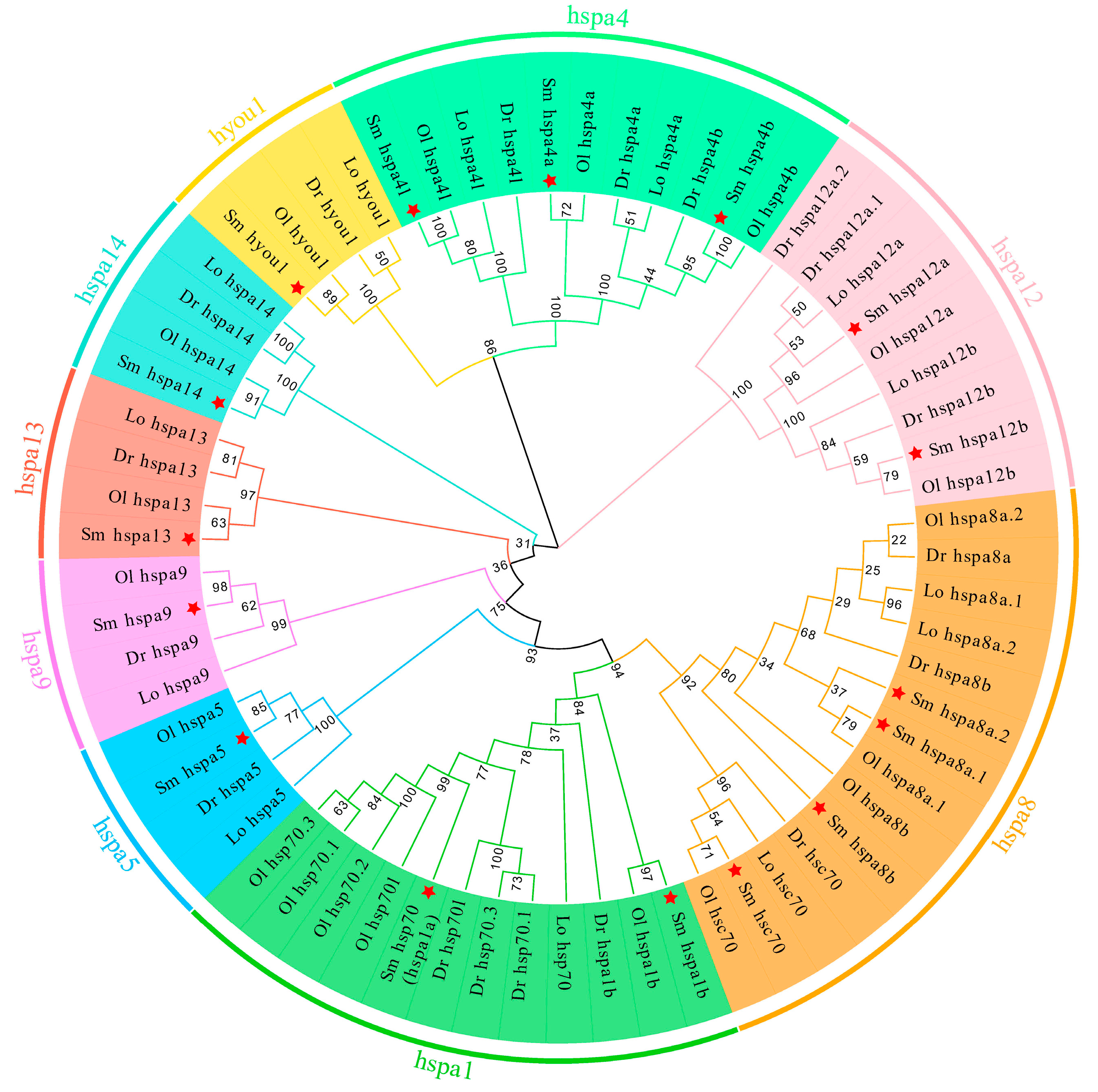


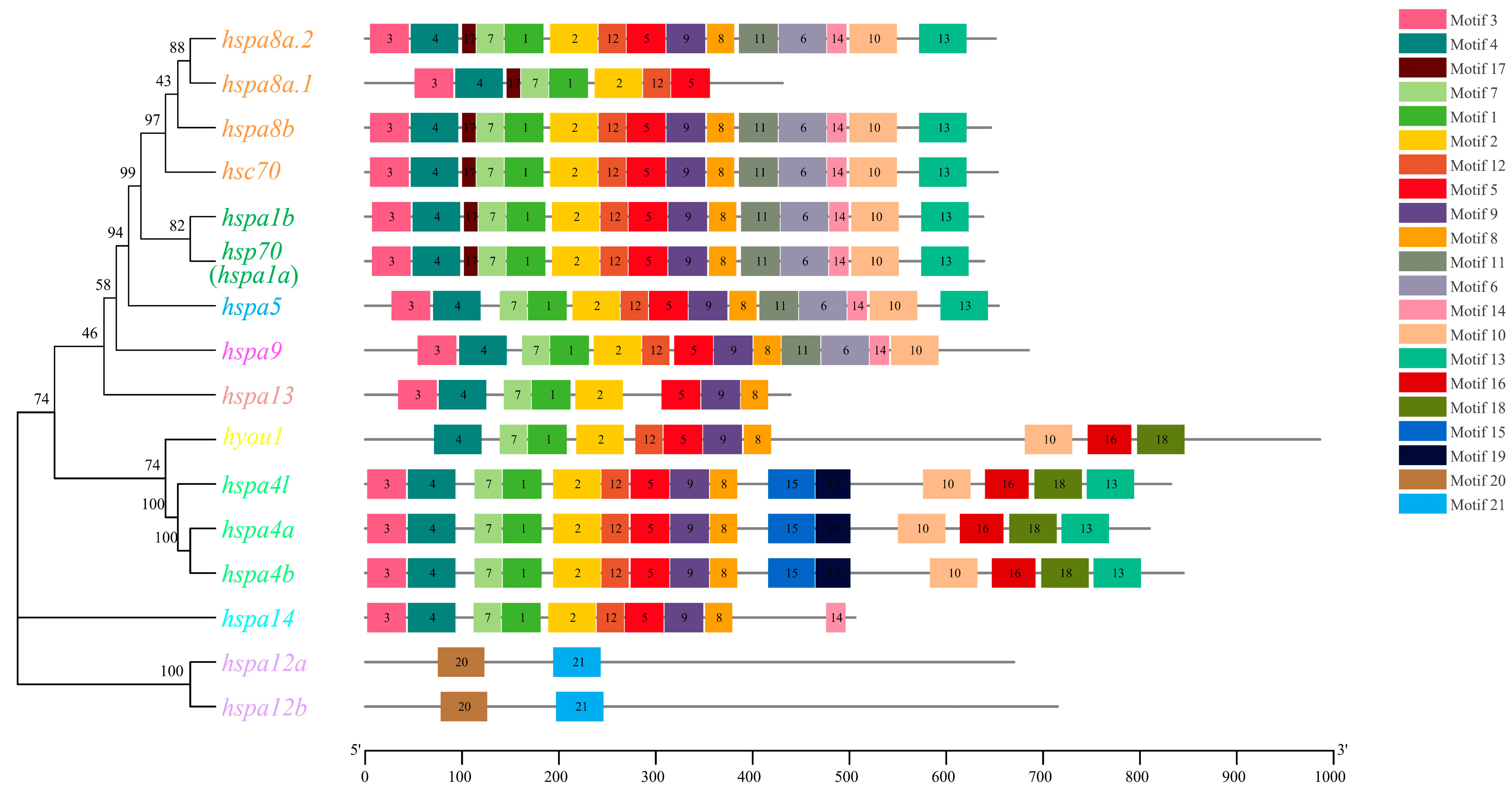
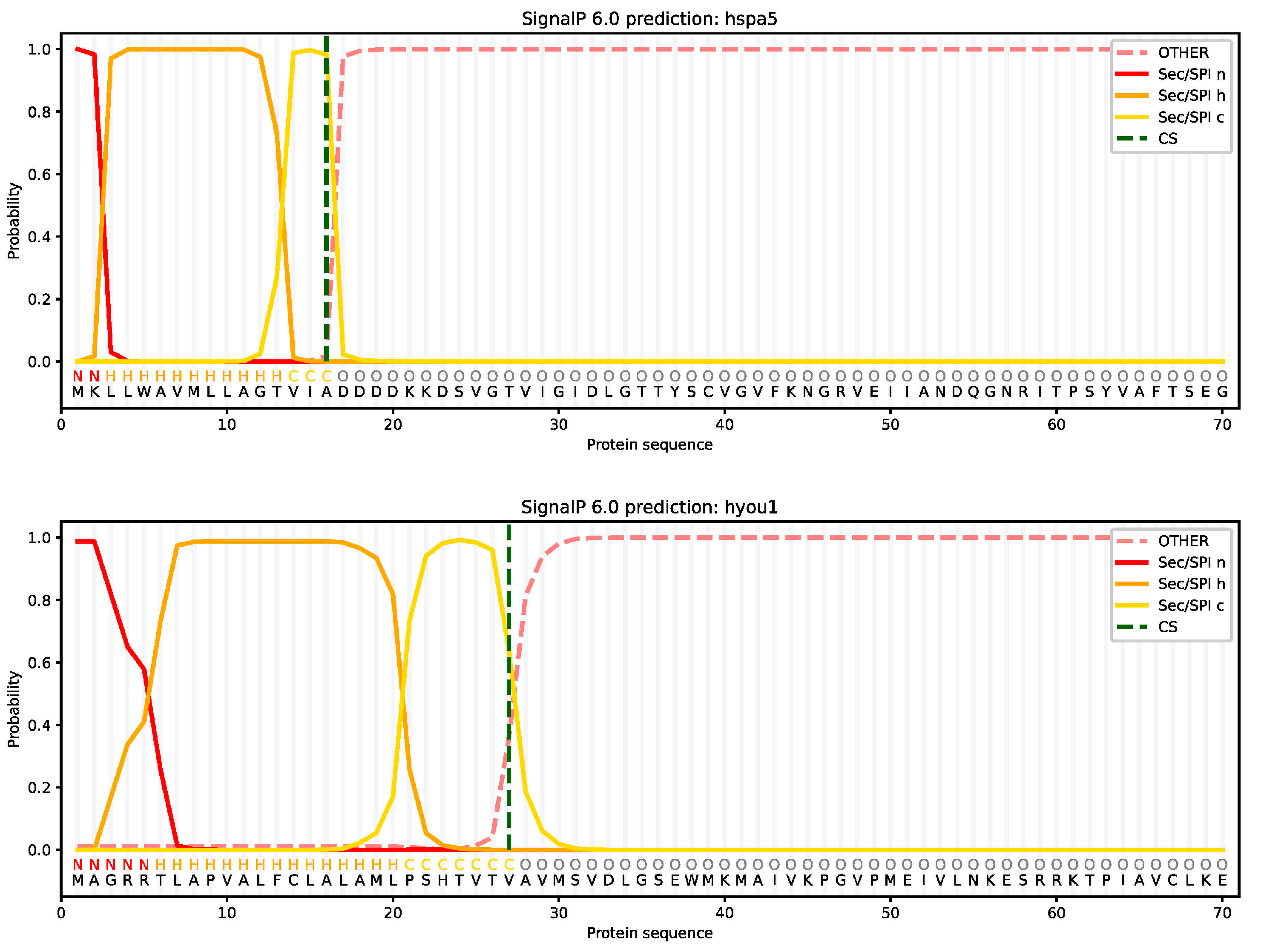
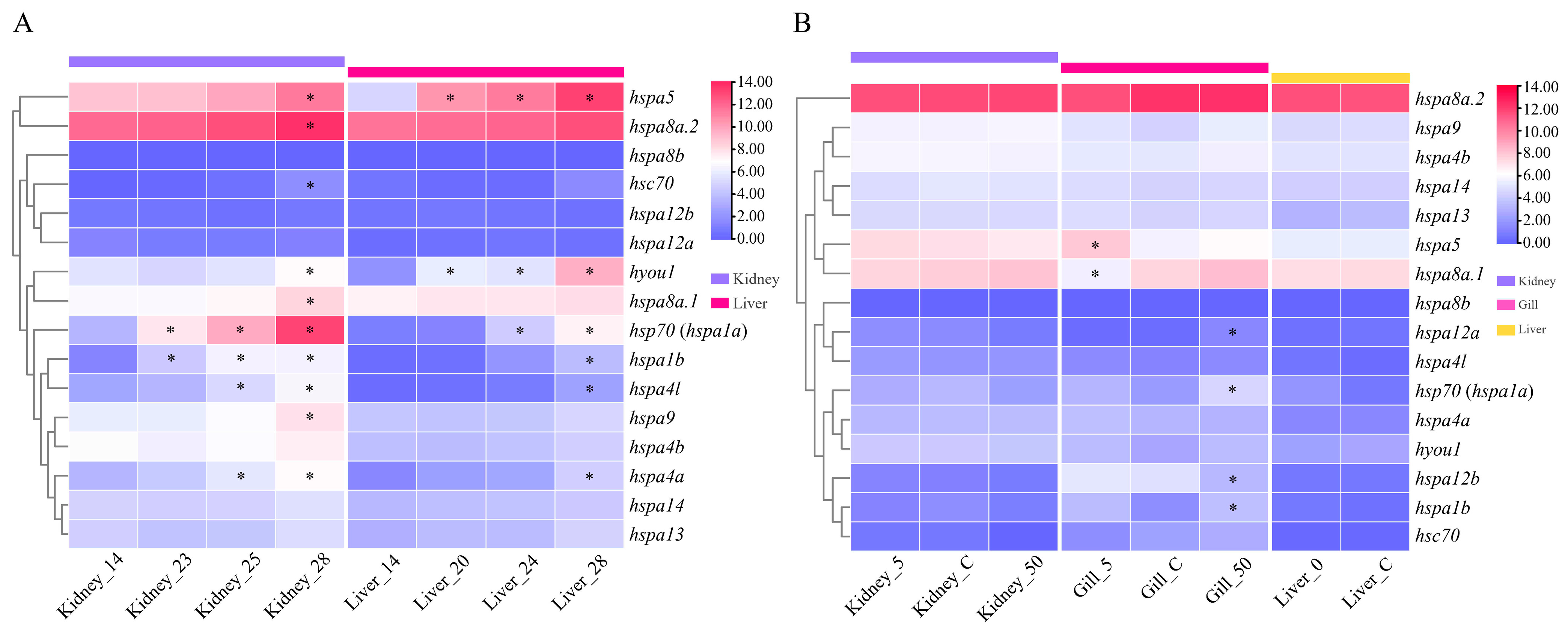

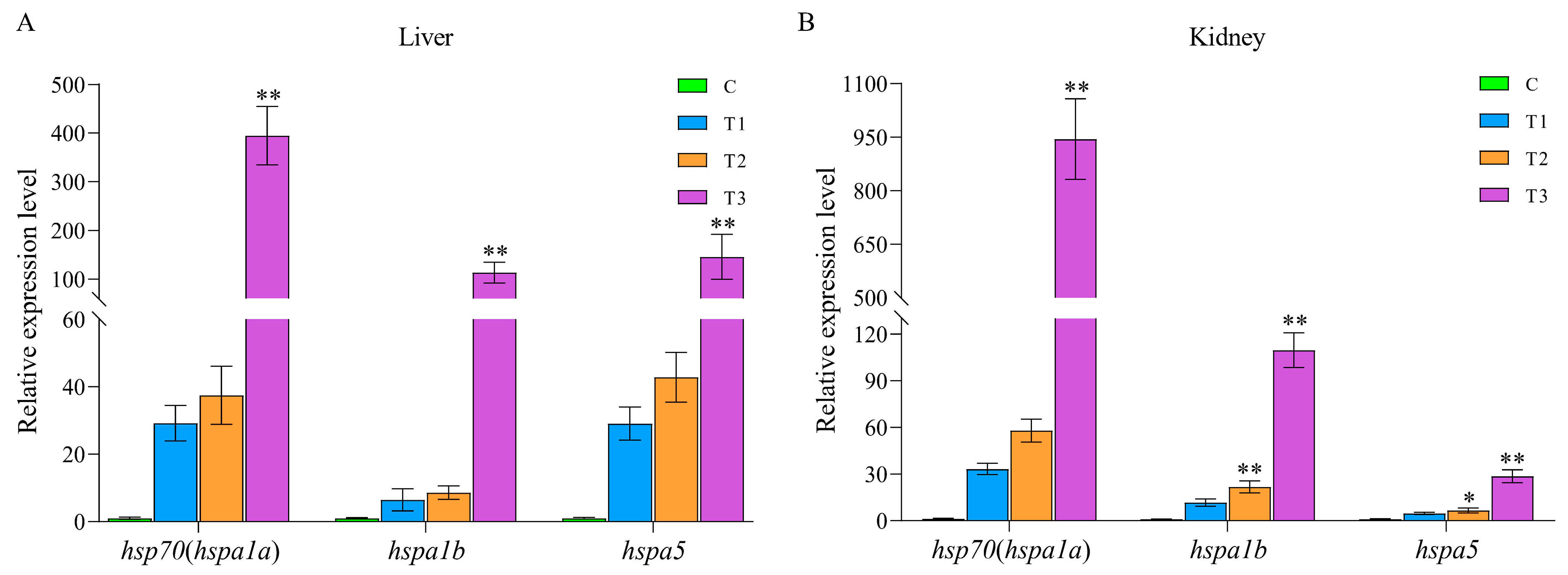
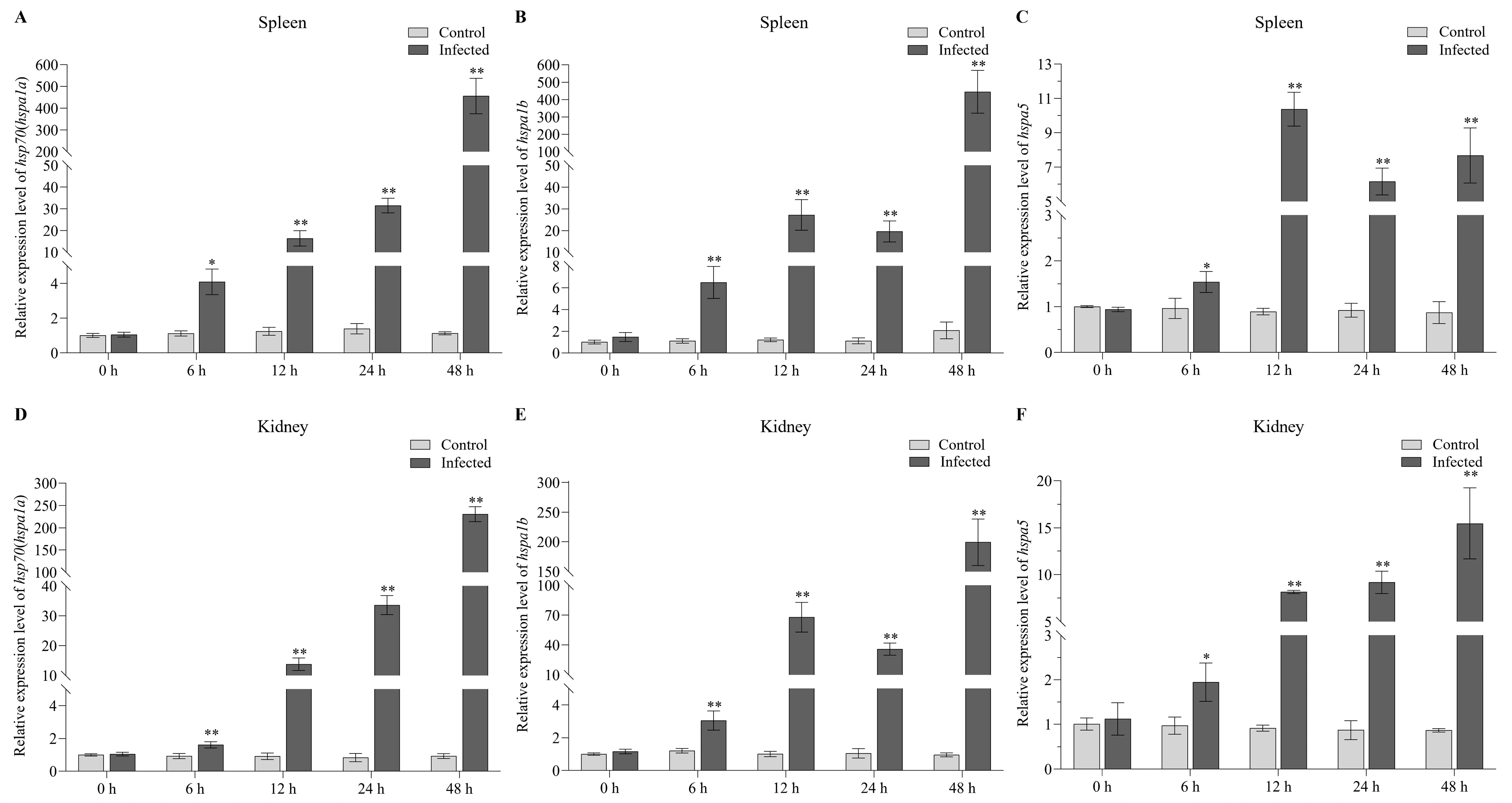
| Group | Gene Name | Chr | Gene Length (bp) | Numbers of Amino Acids | MW (Da) | pI | Domain | Domain Location (aa) |
|---|---|---|---|---|---|---|---|---|
| hspa1 | hspa1b | Chr3 | 2780 | 638 | 70,307.59 | 5.42 | HSPA1-2_6-8-like_NBD | 8-383 |
| hsp70 (hspa1a) | Chr17 | 2464 | 639 | 70,233.30 | 5.44 | HSPA1-2_6-8-like_NBD | 8-383 | |
| hspa4 | hspa4a | Chr2 | 14,103 | 810 | 90,727.11 | 5.3 | HSPA4_NBD | 2-384 |
| hspa4b | Chr9 | 8098 | 845 | 94,849.45 | 5.04 | HSPA4_NBD | 2-384 | |
| hspa4l | Chr15 | 8780 | 832 | 93,131.57 | 5.35 | HSPA4_NBD | 2-384 | |
| hspa5 | hspa5 | Chr20 | 3922 | 654 | 72,220.73 | 5.0 | HSPA5-like_NBD | 26-401 |
| hspa8 | hspa8a.1 | Chr2 | 2990 | 431 | 48,133.63 | 6.87 | HSPA1-2_6-8-like_NBD | 52-367 |
| hspa8a.2 | Chr2 | 4781 | 651 | 71,225.32 | 5.26 | HSPA1-2_6-8-like_NBD | 6-381 | |
| hspa8b | Chr11 | 4378 | 646 | 70,684.97 | 5.36 | HSPA1-2_6-8-like_NBD | 6-381 | |
| hsc70 | Chr1 | 4665 | 653 | 71,324.65 | 5.27 | HSPA1-2_6-8-like_NBD | 6-381 | |
| hspa9 | hspa9 | Chr9 | 8965 | 685 | 74,100.10 | 6.09 | HSPA9-like_NBD | 52-428 |
| hspa12 | hspa12a | Chr10 | 28,355 | 670 | 74,993.54 | 6.57 | HSPA12A_like_NBD | 54-520 |
| hspa12b | Chr2 | 15,095 | 715 | 79,467.95 | 8.48 | HSPA12B_like_NBD | 57-554 | |
| hspa13 | hspa13 | Chr11 | 4707 | 439 | 47,641.75 | 5.91 | HSPA13-like_NBD | 23-431 |
| hspa14 | hspa14 | Chr2 | 8663 | 506 | 54,385.87 | 5.99 | HSPA14-like_NBD | 2-376 |
| hyou1 | hyou1 | Chr2 | 18,128 | 986 | 110,913.87 | 5.01 | HYOU1-like_NBD | 30-416 |
| Gene Pair | Ka | Ks | Ka/Ks Ratio |
|---|---|---|---|
| hspa4a-hspa4b | 0.141613 | 1.856839 | 0.076266 |
| hspa4a-hspa4l | 0.251061 | 2.949802 | 0.085111 |
| hspa4b-hspa4l | 0.266541 | 3.017919 | 0.08832 |
| hspa8a.1-hspa8b | 0.14824 | 1.739731 | 0.085209 |
| hspa8a.2-hspa8b | 0.061431 | 1.285885 | 0.047773 |
| hspa8a.1-hspa8a.2 | 0.120179 | 0.469765 | 0.255827 |
| hspa1b-hsp70 | 0.080952 | 1.274974 | 0.063493 |
| hspa12a-hspa12b | 0.285699 | 1.211086 | 0.235903 |
| Gene Name | Alpha Helix | Extended Strand | Beta Turn | Random Coil | Subcellular Location |
|---|---|---|---|---|---|
| hspa4b | 43.55% | 13.61% | 3.31% | 39.53% | cytosol |
| hspa4a | 44.32% | 14.20% | 3.70% | 37.78% | cytosol |
| hspa4l | 43.87% | 13.82% | 3.73% | 38.58% | cytosol |
| hyou1 | 50.51% | 12.37% | 3.75% | 33.37% | cytosol |
| hspa12a | 32.39% | 19.10% | 4.03% | 44.48% | cytosol |
| hspa8a.1 | 41.76% | 20.19% | 5.10% | 32.95% | extracellular |
| hspa12b | 32.73% | 19.02% | 5.31% | 42.94% | cytosol |
| hspa13 | 42.60% | 21.18% | 6.61% | 29.61% | cytosol |
| hsp70 (hspa1a) | 41.78% | 18.94% | 6.73% | 32.55% | cytosol |
| hspa8a.2 | 41.32% | 18.13% | 6.76% | 33.79% | cytosol |
| hspa9 | 41.61% | 19.56% | 6.86% | 31.97% | mitochondrial |
| hspa14 | 37.55% | 23.72% | 6.92% | 31.82% | cytosol |
| hsc70 | 41.50% | 18.22% | 7.04% | 33.23% | nuclear |
| hspa5 | 44.04% | 18.35% | 7.19% | 30.43% | extracellular |
| hspa8b | 42.41% | 17.96% | 7.28% | 32.35% | cytosol |
| hspa1b | 43.10% | 18.50% | 7.37% | 31.03% | endoplasmic reticulum |
Disclaimer/Publisher’s Note: The statements, opinions and data contained in all publications are solely those of the individual author(s) and contributor(s) and not of MDPI and/or the editor(s). MDPI and/or the editor(s) disclaim responsibility for any injury to people or property resulting from any ideas, methods, instructions or products referred to in the content. |
© 2023 by the authors. Licensee MDPI, Basel, Switzerland. This article is an open access article distributed under the terms and conditions of the Creative Commons Attribution (CC BY) license (https://creativecommons.org/licenses/by/4.0/).
Share and Cite
Zheng, W.; Xu, X.; Chen, Y.; Wang, J.; Zhang, T.; E, Z.; Chen, S.; Liu, Y. Genome-Wide Identification, Molecular Characterization, and Involvement in Response to Abiotic and Biotic Stresses of the HSP70 Gene Family in Turbot (Scophthalmus maximus). Int. J. Mol. Sci. 2023, 24, 6025. https://doi.org/10.3390/ijms24076025
Zheng W, Xu X, Chen Y, Wang J, Zhang T, E Z, Chen S, Liu Y. Genome-Wide Identification, Molecular Characterization, and Involvement in Response to Abiotic and Biotic Stresses of the HSP70 Gene Family in Turbot (Scophthalmus maximus). International Journal of Molecular Sciences. 2023; 24(7):6025. https://doi.org/10.3390/ijms24076025
Chicago/Turabian StyleZheng, Weiwei, Xiwen Xu, Yadong Chen, Jing Wang, Tingting Zhang, Zechen E, Songlin Chen, and Yingjie Liu. 2023. "Genome-Wide Identification, Molecular Characterization, and Involvement in Response to Abiotic and Biotic Stresses of the HSP70 Gene Family in Turbot (Scophthalmus maximus)" International Journal of Molecular Sciences 24, no. 7: 6025. https://doi.org/10.3390/ijms24076025
APA StyleZheng, W., Xu, X., Chen, Y., Wang, J., Zhang, T., E, Z., Chen, S., & Liu, Y. (2023). Genome-Wide Identification, Molecular Characterization, and Involvement in Response to Abiotic and Biotic Stresses of the HSP70 Gene Family in Turbot (Scophthalmus maximus). International Journal of Molecular Sciences, 24(7), 6025. https://doi.org/10.3390/ijms24076025






